Ok here it is, everything you wanted to know about the weather in Vietnam. I usually start my writings from South to north, so let me be a rebel and start in the north.
SAPA
The climate of Sapa is highly seasonal, with a subtropical climate in the summer and a temperate climate during the winter. Average temperature for Sapa town is 15.4ºC, with a maximum of 29.4ºC and a minimum of 1ºC. Sapa also experiences a marked wet season from May to September, with the heaviest rainfall occurring in July and August. The weather is also notorious for changing frequently and quickly. It is said that only in Sapa, one can experience many different seasons within only one day.
February- Very cold in early days, cloudy, foggy. Getting warmer & better towards later days.
March- Much nicer and warmer weather than Feb, more sunshine
April- Summer start, dry, clear, warm enough
May- Starting rainy season with quick shower occasionally, clear sky with more sunshine but little bit warm in the open at noon.
June- Warm but not as hot like other region. Clear sky, much sunshine but summer shower get more but not too wet
July- Among the 2 worst months of the year caused by summer shower
August – The peak month of typhoon and rain
September – Autumn starts, getting drier and normally very nice towards the end of the month.
October- Cool, dry, sunshine almost everyday, clear sky
November- Cooler, dry. May be misty and foggy towards the end but nice weather.
December-Wet winter starts and gets worse in the later days of the month. It can get quite chilly.
Halong Bay
Halong’s climate is humid and tropical. With a hot, humid summer and dry, cold winter; Halong’s temperature varies from 15ºC to 25ºC.Annual rainfall is between 2000mm and 2200mm. Ha Long bay has typical diurnal tide system (tide amplitude ranges from 3.5-4m). The salinity is from 31 to 34.5MT in dry season and lower in rainy season. It is possible to visit Ha Long Bay year-round, with the best time to visit from October through April, although during the winter months of December, January and February, the weather can be cool and overcast with low visibility. During the summer months from May to September, temperatures rise and storms are more likely during the rainy season.
Hanoi,
Hanoi has typical North Vietnam climate, with a cold and dry winter (when temperatures can drop to as low as 6°C – 7°C) and a hot and extremely humid summer (temperatures can climb up to a maximum of 35°C). Spring is characterized with light drizzles while the summers bring heavy rain. The best time to visit Hanoi is around September to November or from March to April for their milder temperatures and pleasant weather.
Average Rainfall millimeters
Average Temperature
Hue/ Danang
The coast and delta area of Hue has tropical climate and is divided into two distinguished seasons. The dry season (from March to August) has a maximum temperature of 400 C and the colder, rainy season (August to January) has temperatures that can go down to 19,70 C. In higher areas (on mountains, highlands) the temperature is generally cooler. From March to August will be the best time to visit Hue, especially between March and April when the temperature is more pleasant, though rainfalls are still likely. Hue sees fog and rain quite frequently, even when the weather across the Hai Van Pass in nearby Danang is sunny. During the rainy season, between September and January, rain is more frequent and can be heavy.
Weather chart for Hue/Danang/Hoi An area
Average Rainfall centimeters.
Average Temperature
Hoi An
Somewhere between tropical and climate. The temperature is warm throughout the year (average 29°C), yet hotter around months June and July and cooler around December. Hoi An is affected by monsoon winds. The city will be constantly raining from September till January, and dry for the rest of the year. Overall, the best time to visit Hoi An is between May and June. February and April are among the best time to visit Hoi an when rainfall is low and temperatures are pleasant. The temperatures can get hot during summer time and during the rainy season, particularly during October and November, rains can be frequent and heavy.
Nha Trang
Nha Trang is extremely lucky to not be influenced by monsoon winds that turn the rest of southern Vietnam into water six months every year. Nha Trang has a warm, fair and beautiful climate nearly all year round, with the exception of late October, November and early December. The best time to visit Nha Trang would probably be March or April. The least windy months of the year are May, April and June. Nha Trang in general is not windy enough to windsurf, with the exception of Doc Let beach (35 km north of Nha Trang), which is usually reserved for experts.
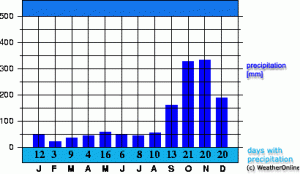
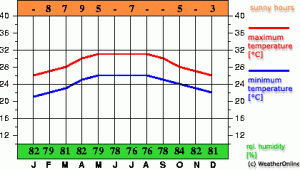
Dalat
Surrounded by mountains and pine forests, Da Lat has many characteristics of a temperate climate. The average temperature here is 18–21°C, with highest temperature 30°C and lowest 5°C. Dalat also has the two season climate typical of South Vietnam, with a monsoon season from May to October and a dry season from November to April. Dalat is never stormy and only has occasional heavy winds from the ocean through the mountains East side of the city. Dalat is in the temperate region and has pleasant weather year-round, even sunny during much of the rainy season. The dry season lasting from November to March, and the rainy season from April to November. During the winter months, the average temperature is 10 C while during summer it is around 20 C. Ideal weather is from November to March, when the air is fresh and cool.
Mui Ne
Mui Ne lies in the monsoon tropical zone, with 2 district seasons. The rainy season is from May to October and the dry season from November to April. Dry season normally means NO RAIN. Mui Ne lies in the emerging Binh Thuan Desert and is prone to drought. Onset of rainy season can bring flash flooding and extensive errosion. Rainy season brings lush green foliage and the return of birds, butterflies and other wildlife (and takes away the tourists). Rain is usually for an hour, once or twice a day (typically afternoon and evening), during the rainy season. The yearly average rainfall varies between 50 and 100 cm. The average relative humidity is 79%. Because Mui Ne receives very little rain, it is also sunnier, and thus feels hotter than Nha Trang or Ho Chi Minh City.
Ho Chi Minh City weather and climate
Located in South Vietnam, Ho Chi Minh City city has a tropical climate. The average humidity level is 75%, average temperature is 28 °C. The city is generally warm, and has a monsoon season from May to November and a dry season from December to April. During the rainy season starting from May to November, rains can be long and heavy, but often are short daily rains that clear quickly. Generally, the best time to visit is during the dry season from December and April, although the coolest months are October through December.
Average rainfall in Saigon
Average temperature in Saigon
Phu Quoc
The island’s monsoonal sub-equatorial climate is characterized by distinct rainy (June to October) and dry seasons (November to May). The annual rainfall is high averaging 2,879 mm. In the northern mountains up to 4,000 mm have been recorded. April and May are the hottest months with temperature reaching 35 °C. Trips to Phu Quoc can be made all year round, but the best time is dry season when the sky is always sunny, clear and blue.
So there you have it!! I wish to thank all of the sites I copied from. It was a bit hard compiling this information into one place, and your sites helped immensely.
Update.
Here is another link to rainfall and temperature charts with more detailed information

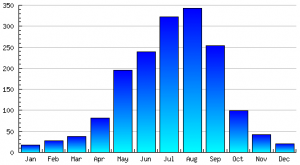
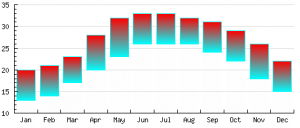
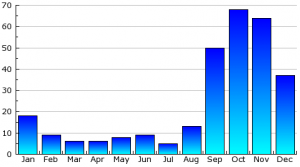


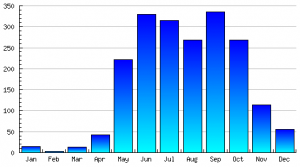

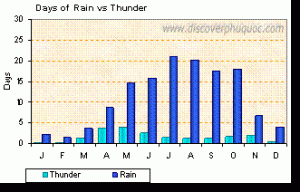
Hi Owee,
I’ve been to Vietnam 7 times, especially around Danang/Hoi An for work. My fiancé and I love it so much we want to honeymoon there in mid march next year. Our plan is to hang out in Saigon a few days (cause we love it) and then chill out somewhere a bit special and private e.g. One of the six senses properties. But when I was in Danang last month I noticed the intercontinental danang was nearing completion and looks quite a special place. So here’s my question – Danang in mid march – is it hot enough yet for days lazing in the sun and swimming, or are we better off targeting one of those properties closer to nha trang/mui ne? Sitting in 16 degrees Sydney right now, it’s hard to get a good feel for what 24-27 average highs actually feels like!
My other question is about nha trang. I was there as a back packer in about 1o years ago and remember it being fun, but it does get a lot of negative press these days. After 3-4 days away from the world, we want to stay at a place on the beach (nice hot days) but with reasonable nightlife options. In your opinion is nha trang the place or would we be better off in a place like mui ne? Loved Mui Ne but would want it to have a few more nightlife/bar options than what we had about 5 years ago.
Sorry for all the questions, but looking for any advice to have the best honeymoon.
Cheers,
Andy
The bad press is silly in my books. Some of it is from what Nha Trang used to be but the city has changed a lot and is not deserving of the bad rap. Most of the bad things that happen are in one square block surrounding the sSailing Club where the local scammers know drunk foreigners are.
March can be fine but if windy 24 can feel really cold. I might book short term with intention to extend and head south if too miserable
we arrive in Hanoi on 18th November 3 nights , will have a 1 night Halong Bay trip. we then fly to Da nang, Nha Trang for 4 nights and Ho Chi Min City leaving on 30 th November . Will we need to bring warm clothes, particularly for Hanoi? After recent reading, I guess that the weather wont be too beachy in Nha Trang . Can you give us an insight what to bring please. ( Husband and wife, first visit to Vietnam)
Hi Owee, I’m planning a beach holiday for my family on 2nd week of dec. planning for 3 nights Hanoi, 2 nights Hue, and 4-5 nights in Fusion Maia. My concern is that given it is winter in vietnam, whether the weather will be too cold and rainy for us to chill out by the pool and beach and hence a waste to splash out that much money on a pool villa. I’m still really keen to visit Vietnam and hoping for your perspective.
Thanks,
Kathy
Hi Kathy….. Mid December is the start of the end of rainy season. Hue also suffers some iof the worst weather in Vietnam. check out this chart and decide for yourself. https://owee58.com/wp-content/uploads/2011/07/Hue1.jpg I might keep an open schedule and simply book last minute from Hanoi wherever the weather is good…. IE Hue, Danang, Nha Trang, oreven Phu Quoc
I and my family total 3 person already booked a flight to Danang from 23-09-1012
to 30-09-2012.Is it nice and best time to visit Danang,Hue & Hoi An?Any typhoon,
heavy rainfall?
The rains often start in Mid September as do the storms. The best months to Visit that area is March – July. Hopefully it will be fine, but have a back up destination to go to is weather is bad.
We’re visiting Vietnam for 2 weeks from September 9th, flying in and out of Ho Chi Minh.
Our plans were to visit Phu Quoc, Hoi An and Halong Bay.
We are hoping to see as much sun as possible and was wondering what order is best to travel in.
Thanks so much for your help.
Wow Katrina, a very long distance for 2 weeks. You will find 2 week sample itineraries on the link on top of the page. just replace one of the destinations with Phu Quoc, and be sure to fly everywhere
Hi
We are looking at coming to Vietnam from 7 september to 28th september. How is the rainfall then, we are worried its rainy season?
Also which way should we travel?
Should we start in Ho Chi Minh and head North to Hanoi? Or other way down?
We also want to see Siem Reap and Ankgor Wat….should we do this at the beginning or the end?
Thanks so much in advance
Leigh
Email sent
Thanks so much for putting this together. We are heading over for first 3 weeks in August. Do you think start from the north, Sapa, HLB etc then head south?
We want some beach time as well, would it be a relying on a good beach stay mid way down the coast? Or just be better to save our beach time for the south?
Thanks heaps 🙂
Nha Trang is about fun and beaches. Start wherever you can get the best deal on a flight. I usually prefer the south, but everyone has their own idea.
Hi – we are doing some hurried planning right now to go visit Angkor, Hue, HoiAn, Halong and Hanoi in that order during last week of June and first week of July, what should we expect weather-wise ? Much appreciate to hear your comments . suggestions.
thank you.
June is a great time to travel. Weather should be nice with perhaps afternoon rains.
Hi, All your info is excellent & I have read & re-read weather info for October. If we continue we our plan to come to Nha Trang in October (23rd) would we expect any warmth & sunshine for the beach or is that a big ask? You mentioned on your site that typhoons tend to head more to Hoi An so am hoping that leaves NT as a possibility still.I realize Mui Ne & Phu Quoc are options but do not really believe they have the best combinations of beach, shopping and sightseeing from all that I have researched.We are 1st timers for Vietnam hence the uncertainty.
Hopefully you will have good weather, but it is a hit and miss. This year was quite nice where last year was awful. In my opion, Nt is a much better destination than Phu Quoc or Mui Ne for beaches, but be prepared to move south is bad weather hits.
Thanks for your information. My sister and I are travelling early Oct to Vietnam and not sure whether to go North or South first. We will have nearly 3 weeks. Sometimes I think Oct looks great then in other areas it looks not so good!!!! Kate
If travelling to the Central area at that time, keep your options open